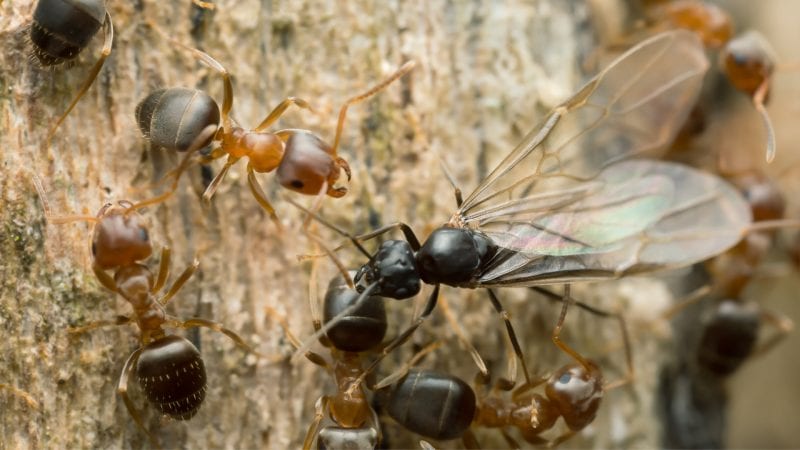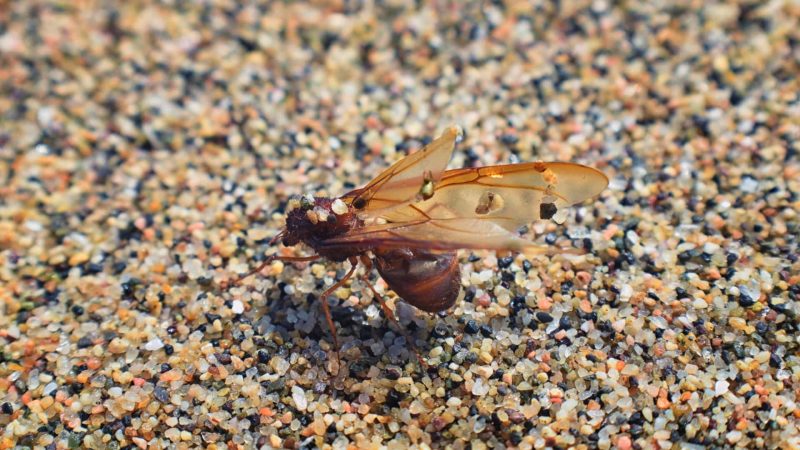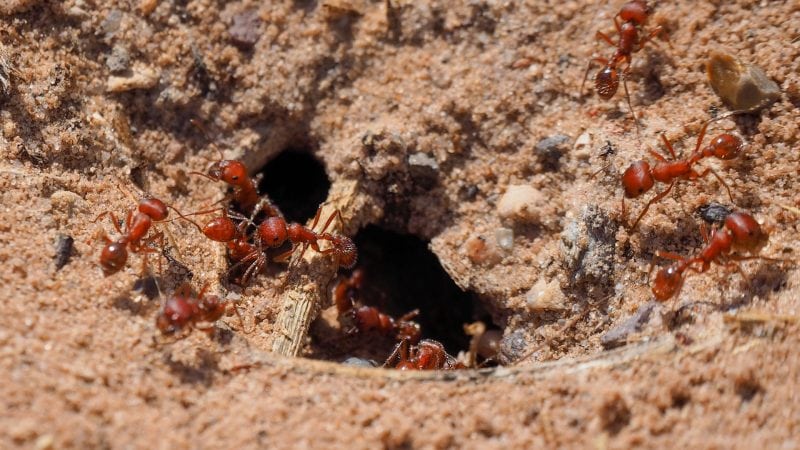There are around 12000 species of ants have been identified till now, and about 700 are present in the USA. In addition, ants are one of the fastest-reproducing insects on the planet.
Do ants lay eggs? Ants do lay eggs, but only the queen may do so. The majority of the eggs the queen lays develop into workers. Their eggs need 7 to 14 days to hatch. If she chooses to fertilize her eggs, female worker ants may emerge from those eggs and, with proper nutrition, develop into queens. Newly hatched male ants are the result when she fails to fertilize her eggs.
To learn more about how ants lay eggs, please continue reading.
The Process Of Ant Reproduction

The most important part of the ant reproduction process is the nuptial flight. Occasionally, the developed ant colony produces flyable mates, alates, and virgin queens. The queen attracts males by releasing pheromones during the nuptial flight.
Mating is conducted in flight; usually, the queen mates with a couple of the fastest males. All ants that are part of the mating process are called the mating swarm. After mating, the queen searches for a suitable spot to start a new colony. Males die quickly after mating.
Also, there are examples of colonies with more than one queen, but that can happen only when there are enough worker ants to support that colony. Worker ants are not fertile; their purpose is to collect food and protect the colony.
After she is done with the mating, the queen loses its wings, and she stores the sperm in a sort of pouch developed for that sole purpose. The pouch is located on a queen’s abdomen.
Ant Queens

Ant queens are the heart of every ant colony. Only queens can mate, reproduce and lay eggs. The whole colony is focused on the queen and her egg’s needs. There are always working ants searching for food for the queen and the eggs. When the eggs hatch, they evolve into larvae and demand specific food. It is one of the responsibilities of the worker ants to tailor the food for the larvae’ needs.
At the beginning of the mating cycle, the queen and the fertile male ants fly above the ant colony, and they can even mate with the ants from other colonies. Ant queen uses pheromones to attract male ants. As a part of the mating ritual, she tries to fly off, and she mates only with a couple of ants fast enough to catch up with her.
In most cases, there is just one ant queen per ant colony, but if there are enough worker ants, there can be more than one queen in a colony. The number of queens depends on the number of working ants that can provide enough food for the queen and her eggs.
Also, the number of ants is essential for protecting the queen and the eggs. The queen can live up to 25 to 30 years depending on the ant species and life conditions.
How Does an Ant Queen Create a New Ant Colony

It is quite interesting to know that the only way to create a new ant colony is for the queen to survive the mating process and move from the old colony to create a new one. Some number of worker ants follow her and practically offer her protection and food.
Without those ants, a queen would never have the chance to fertilize the eggs, and new eggs couldn’t survive. Worker ants are there to build a colony and secure the place for the queen and her eggs.
Because there are so many species of ants, there are, of course, some cases that differ from the standard. There are a couple of ant species where ant queens together to form a new colony and help each other. But, like in all cases, worker ants help the queens and their eggs survive.
What Are Worker Ants, And What Is Their Purpose In Ant Reproduction?
Worker ants are created when a queen ant secretes a chemical that stops the growth of the wings. That way, worker ants are focused on building and expanding the colony.
Worker ants not only build a colony and dig tunnels, but they are also responsible for the queens and their eggs. Without their help, there would be no colony. They protect the colony and supply the queen and the eggs with food.
The queen cannot leave the colony for food because that would be a death sentence for the entire colony, so it all rests on the working ants’ shoulders.
When they find a food source, they leave a scent trail so all the other ants can find food following them. Working ants will move the eggs into the deeper parts of the colony during the night to ensure eggs will remain as warm as possible.
What Is Ant Colony Budding?

Some species of ants have a sort of unique way of reproducing, and it is called colony budding. Budding is when multiple fertile queens leave with working ants to create a new colony.
There is no mating swarm because queens are already fertile and will not be mating anymore. Reasons for this kind of “branching out” are either if the ants feel threatened and need to leave, or the situation is going too well, and a chance to create a new colony just should go wasted.
Species of ants that heavily rely on colony budding are fire ants, argentine ants, pharaoh ants, and ghost ants.
List of Sources
Aron, S., Timmermans, I., & Pearcy, M. (2011), Ant queens adjust egg fertilization to benefit from both sexual and asexual reproduction, Biology Letters
Torres, JA & Snelling, R. & Canals, M.. (2001). Seasonal and nocturnal periodicities in ant nuptial flights in the Tropics (Hymenoptera: Formicidae)
Jesse L., Ant Swarming, Iowa State University
Ant Life Cycle, Harvard University’s Faculty of Arts & Sciences
Heyman, Y., Shental, N., Brandis, A., Hefetz, A., & Feinerman, O. (2017). Ants regulate colony spatial organization using multiple chemical road-signs. Nature communications
- How to Get Rid of Copperheads | Practical Guide - August 27, 2023
- How to Get Rid of Corn Snakes | What Makes Them Aggressive? - August 27, 2023
- How to Get Rid of Alligators | Safety Measures and Removal Methods - July 16, 2023
